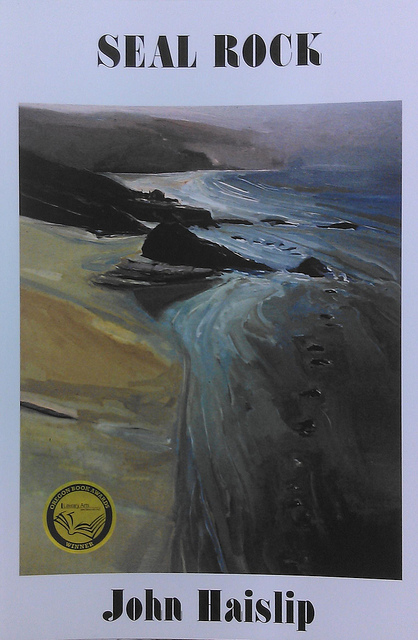On Seal Rock
What is the official color of the Pacific Northwest Coast? Let a poet define it: “…it happens when I begin my little ritual of naming the colors. That’s grey, I say. That is not grey, I say. But more than grey, a white grey, green grey, blue grey, rose grey—my little ritual—and then, and then it overtakes me.”
The poet’s name is John Haislip, the poem is “On the Beach Late Before Sunset” and it concludes Seal Rock, perhaps the finest book of poetry I’ve ever read about the Oregon Coast and the people who inhabit its landscape. Seal Rock nails the magical, primitive, punishing, damp, gray, reclusive nature of surviving on the soggy monochrome coast with the same vigorous accuracy as Ken Kesey did in Sometimes a Great Notion. And I make that claim because I’ve lived at the Oregon Coast for 22 years and have had a lot of wet, grey time to read a lot of poetry about the Pacific Northwest.
I only know of Seal Rock’s existence because of an offhanded remark in a dive bar by my friend, Tim Sproul. We were drinking cheap Pacific Northwest lagers and talking poetry when Sproul told me I had to read the book. He also said he studied under Haislip in the University of Oregon’s MFA program in creative writing in the late 1980s and had great admiration for him as a teacher and mentor. Haislip was a professor emeritus at the university who passed away in March 2011 at the age of 85.
It took some time, but I tracked down a copy in a public library. After reading this slim 52-page volume that won the Oregon Book Award for poetry in 1987, I read it again, photocopied it, annotated it, then drove five miles from my home to the village of Seal Rock at the 150 milepost marker on the Oregon Coast and explored the beaches. There, I walked into John Hailslip’s poetry, his grey.
Seal Rock overtook me in a way no book of poetry has before. It helped me transcend a great personal loss. I sensed I had a mission to herald how incredible these poems are and that’s what I’ve been doing for years. Find a copy. Read the poems and learn. The lessons are tough.
My favorite poem in Seal Rock is “Counting the Gulls.” The last stanza reads:
As now it’s coming on
From who knows how much
Multitudinous grey
Out there all week—
Or through the next?
Or how about the next six months? Haislip writes about grey better than anyone I’ve ever read and one can sense from these poems that he regularly communed with gulls and rain. He also uses the word carcass as a verb, as in, “carcass off in the poisoned air,” and I’ll never get that image out of my head, which is what great poetry is supposed to do, not make you feel confused or unintelligent.

